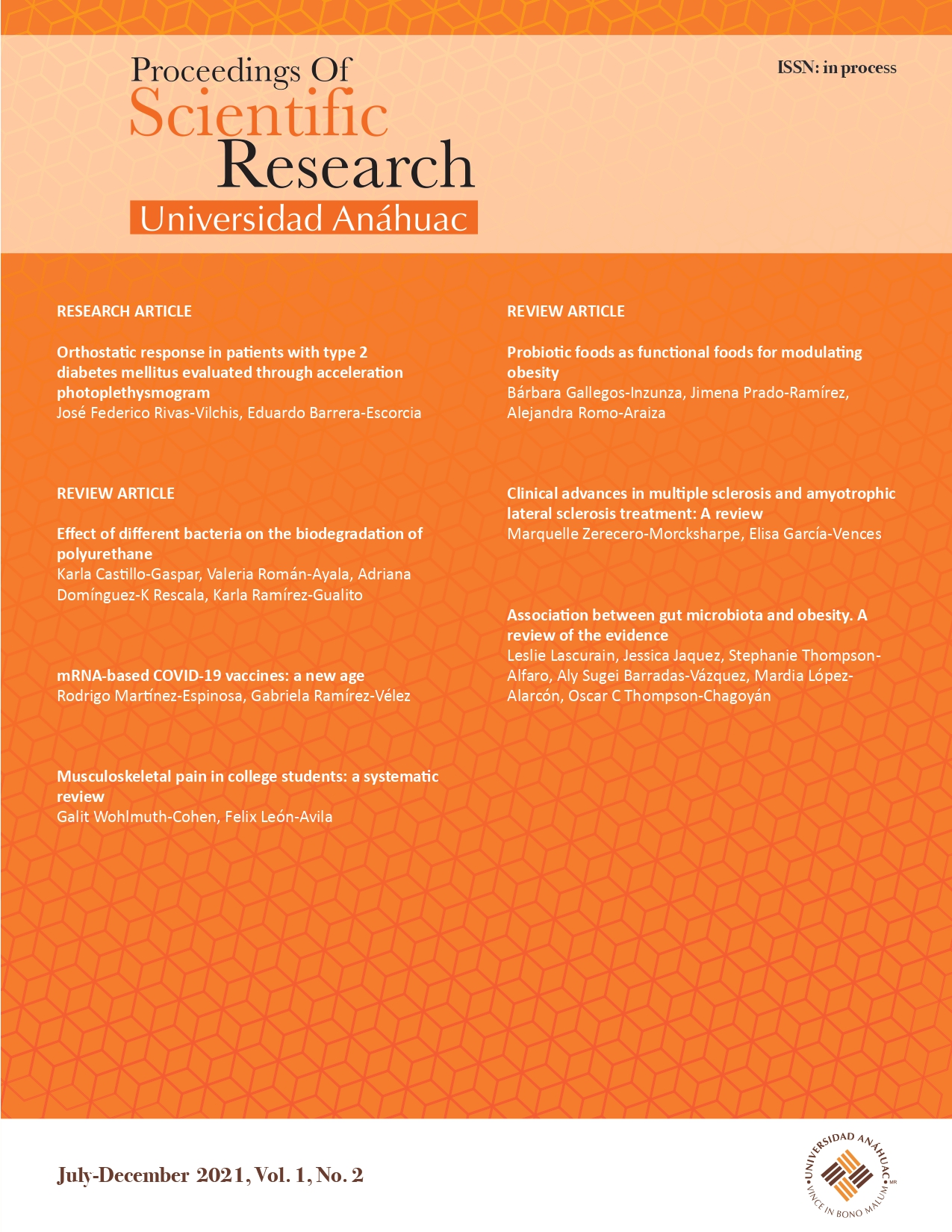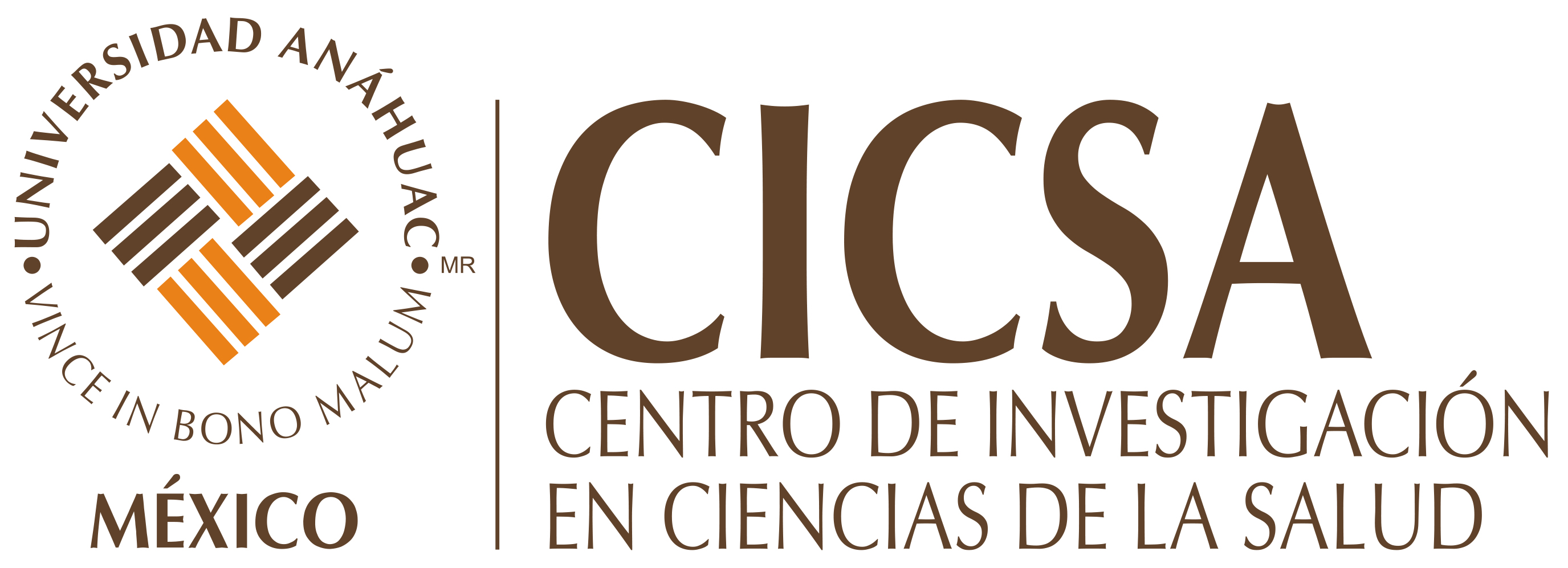Orthostatic response in patients with type 2 diabetes mellitus evaluated through acceleration photoplethysmogram
DOI:
https://doi.org/10.36105/psrua.2021v1n2.01Keywords:
orthostatism, acceleration photoplethysmogram indices, type 2 diabetes, arterial stiffnessAbstract
Introduction: One of the striking complications of diabetes mellitus is arterial circulatory dysfunction. The 30:15 ratio is an orthostatic index commonly used to diagnose circulatory alterations in diabetic patients with a long evolution. Indices obtained from the second derivative of photoplethysmogram (SDPPG) or acceleration photoplethysmogram (APG) characterize arterial pathological changes. Aim: To compare the cardiovascular response of non-diabetic subjects to active standing versus that of type-2 diabetes (DM2) patients using APG indices. Methods: Digital photoplethysmography (PPG) was obtained from healthy subjects (n = 15, age ± SD, 44.6 ± 7.2 years) and DM2 patients (n = 15, age ± SD, 48.3 ± 7.9 years). The 30:15 ratio, b/a, d/a, and APG-AI, all APG-based, of the participants were calculated and compared at baseline, 15 and 30 s. Results: Comparison of the 30:15 ratios between groups did not show a significant difference. No significant differences were observed between the APG indices in the two groups in the baseline period. However, d/a decreased, and APG-AI increased significantly at beat 30 after active standing in non-diabetic subjects. Values of APG indices in DM2 patients did not show significant changes. Conclusion: The results suggest that APG indices could be used to detect early vascular dysfunctions in DM2 patients.
Downloads
PLUMX metrics
References
2. Yun JS, Park YM, Cha SA, Ahn YB, Ko SH. Progression of cardiovascular autonomic neuropathy and cardiovascular disease in type 2 diabetes. Cardiovasc Diabetol. 2018;17(1):109. http://doi: 10.1186/s12933-018-0752-6
3. Breder ISS, Sposito AC. Cardiovascular autonomic neuropathy in type 2 diabetic patients. Rev Assoc Med Bras. (1992). 2019;65(1):56-60. http://doi: 10.1590/1806-9282.65.1.56
4. Lin K, Wei L, Huang Z, Zeng Q. Combination of Ewing test, heart rate variability, and heart rate turbulence analysis for early diagnosis of diabetic cardiac autonomic neuropathy. Medicine (Baltimore). 2017;96(45):e8296. http://doi: 10.1097/MD.0000000000008296
5. Spallone V, Bellavere F, Scionti L, et al. Recommendations for the use of cardiovascular tests in diagnosing diabetic autonomic neuropathy. Nutr Metab Cardiovasc Dis. 2011;21:69-78. http://doi: 10.1016/j.numecd.2010.07.005
6. Borst C, Wieling W, van Brederode JF, Hond A, de Rijk LG, Dunning AJ. Mechanisms of initial heart rate response to postural change. Am J Physiol.1982;243(5):H676-81. http://doi: 10.1152/ajpheart.1982.243.5.H676
7. Freeman R, Abuzinadah AR, Gibbons C, Jones P, Miglis MG, Sinn DI. Orthostatic Hypotension: JACC State-of-the-Art Review. J Am Coll Cardiol. 2018;72(11):1294-1309. http://doi: 10.1016/j.jacc.2018.05.079
8. Furlan R, Porta A, Costa F, Tank J, Baker L, Schiavi R, Robertson D, Malliani A, Mosqueda-Garcia R. Oscillatory patterns in sympathetic neural discharge and cardiovascular variables during orthostatic stimulus. Circulation. 2000;101(8):886-92. http://doi: 10.1161/01.cir.101.8.886
9. Gonzales R, Manzo A, Delgado J, Padilla JM, Trenor B, Saiz J. A computer base photoplethysmographic vascular analyser through derivatives. Comp Cardiol. 2008; 35:177-80. http://doi: 10.1109/CIC.2008.4749006
10. Takazawa K, Tanaka N, Fujita M, Matsuoka O, Saiki T, Aikawa M, et al. Assessment of vasoactive agents and vascular aging by the second derivative of photoplethysmogram waveform. Hypertension. 1998;32:365–70. http://doi: 10.1161/01.hyp.32.2.365
11. Hashimoto J, Watabe D, Kimura A, Takahashi H, Ohkubo T, Totsune K, Imai Y. Determinants of the second derivative of the finger photoplethysmogram and brachial-ankle pulse-wave velocity: the Ohasama study. Am J Hypertens. 2005;18(4 Pt 1):477-85. http://doi: 10.1016/j.amjhyper.2004.11.009
12. Ohshita K, Yamane K, Ishida K, Watanabe H, Okubo M, Kohno N. Post-challenge hyperglycaemia is an independent risk factor for arterial stiffness in Japanese men. Diabet Med. 2004;21:636-39. http://doi: 10.1111/j.1464-5491.2004.01161.x
13. Imanaga I, Hara H, Koyanagi S, Tanaka K. Correlation between wave components of the second derivative of plethysmogram and arterial distensibility. Jpn Heart J 1998; 39:775-84. http://doi: 10.1536/ihj.39.775
14. Hashimoto J, Chonan K, Aoki Y, Nishimura T, Ohkubo T, Hozawa A, et al. Pulse wave velocity and the second derivative of the finger photoplethysmogram in treated hypertensive patients: their relationship and associating factors. J Hypertens. 2002; 20:2415-22. http://doi: 10.1097/00004872-200212000-00021
15. Otsuka T, Kawada T, Katsumata M, Ibuki C. Utility of second derivative of the finger photoplethysmogram for the estimation of the risk of coronary heart disease in the general population. Circ J. 2006;70:304-10. http://doi: 10.1253/circj.70.304
16. Bortolotto LA, Blacher J, Kondo T, Takazawa K, Safar ME. Assessment of vascular aging and atherosclerosis in hypertensive subjects: second derivative of photoplethysmogram versus pulse wave velocity. Am J Hypertens. 2000;13:165-71. http://doi: 10.1016/s0895-7061(99)00192-2
17. Ewing DJ, Martyn CN, Young RJ, Clarke BF. The value of cardiovascular autonomic function tests: 10 years experience in diabetes. Diabetes Care. 1985;8(5):491-8. http://doi: 10.2337/diacare.8.5.491
18. Abraham A, Barnett C, Katzberg HD, Lovblom LE, Perkins BA, Bril V. Toronto Clinical Neuropathy Score is valid for a wide spectrum of polyneuropathies. Eur J Neurol. 2018;25(3):484-90. http://doi: 10.1111/ene.13533
19. Kawada T, Otsuka T. Factor structure of indices of the second derivative of the finger photoplethysmogram with metabolic components and other cardiovascular risk indicators. Diabetes Metab J. 2013;37(1):40-5. http://doi: 10.4093/dmj.2013.37.1.40
20. Otsuka T, Kawada T, Katsumata M, Ibuki C, Kusama Y. Independent determinants of second derivative of the finger photoplethysmogram among various cardiovascular risk factors in middle-aged men. Hypertens Res. 2007;30(12):1211-8. http://doi: 10.1291/hypres.30.1211
21. Munir S, Guilcher A, Kamalesh T, Clapp B, Redwood S, Marber M, Chowienczyk P. Peripheral augmentation index defines the relationship between central and peripheral pulse pressure. Hypertension. 2008;51(1):112-8. http://doi: 10.1161/HYPERTENSIONAHA.107.096016
22. Kohjitani A, Miyata M, Iwase Y, Sugiyama K. Responses of the second derivative of the finger photoplethysmogram indices and hemodynamic parameters to anesthesia induction. Hypertens Res. 2012;35(2):166-72. http://doi: 10.1038/hr.2011.152
23. Kimura Y, Takamatsu K, Fujii A, Suzuki M, Chikada N, Tanada R, Kume Y, Sato H. Kampo therapy for premenstrual syndrome: efficacy of Kamishoyosan quantified using the second derivative of the fingertip photoplethysmogram. J Obstet Gynaecol Res. 2007;33(3):325-32. http://doi: 10.1111/j.1447-0756.2007.00531.x
24. Tabara Y, Igase M, Okada Y, Nagai T, Miki T, Ohyagi Y, Matsuda F, Kohara K. Usefulness of the second derivative of the finger photoplethysmogram for assessment of end-organ damage: The J-SHIPP study. Hypertens Res. 2016;39(7):552-6. http://doi: 10.1038/hr.2016.18
25. Kannenkeril D, Bosch A, Harazny J, Karg M, Jung S, Ott C, Schmieder RE. Early vascular parameters in the micro- and macrocirculation in type 2 diabetes. Cardiovasc Diabetol. 2018;17(1):128. http://doi: doi: 10.1186/s12933-018-0770-4
26. Drinkwater JJ, Chen FK, Brooks AM, Davis BT, Turner AW, Davis TME, Davis WA. The association between carotid disease, arterial stiffness and diabetic retinopathy in type 2 diabetes: the Fremantle Diabetes Study Phase II. Diabet Med. 2021;38(4):e14407. http://doi: doi: 10.1111/dme.14407
Downloads
Published
How to Cite
Issue
Section
License
Copyright (c) 2021 José Federico Rivas-Vilchis, Eduardo Barrera-Escorcia

This work is licensed under a Creative Commons Attribution-NonCommercial-NoDerivatives 4.0 International License.
All the intellectual content found in this publication is licensed to the consumer public under the figure of Creative Commons©, unless the author of said content has agreed otherwise or limited said faculty to "Proceedings of Scientific Research Universidad Anáhuac. Multidisciplinary Journal of Healthcare©" or "Universidad Anáhuac Mexico©" in writing and expressly.
Proceedings of Scientific Research Universidad Anáhuac. Multidisciplinary Journal of Healthcare is distributed under a Creative Commons Attribution-NonCommercial-NoDerivatives 4.0 International License.
The author retains the economic rights without restrictions and guarantees the journal the right to be the first publication of the work. The author is free to publish his article in any other medium, such as an institutional repository.













